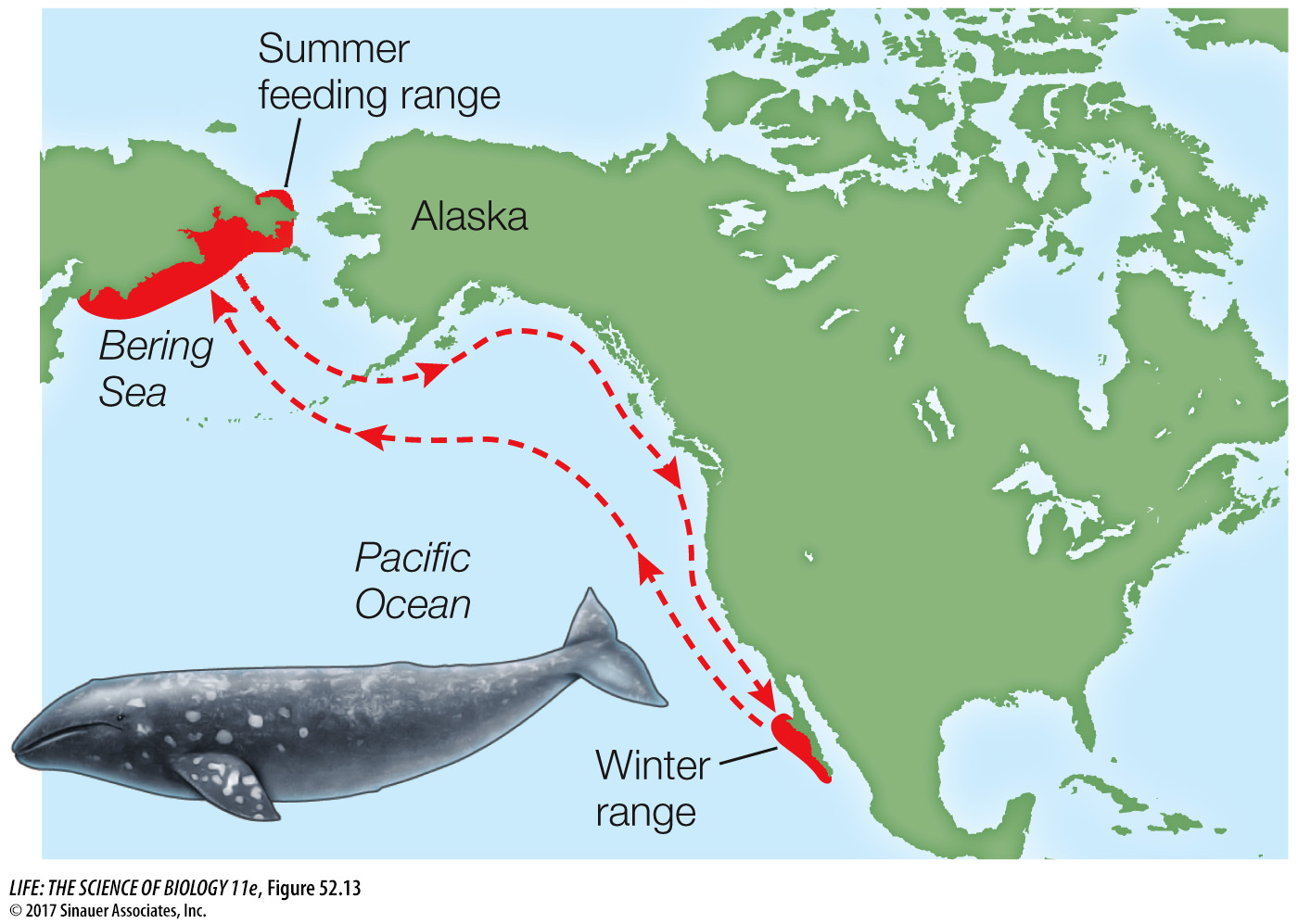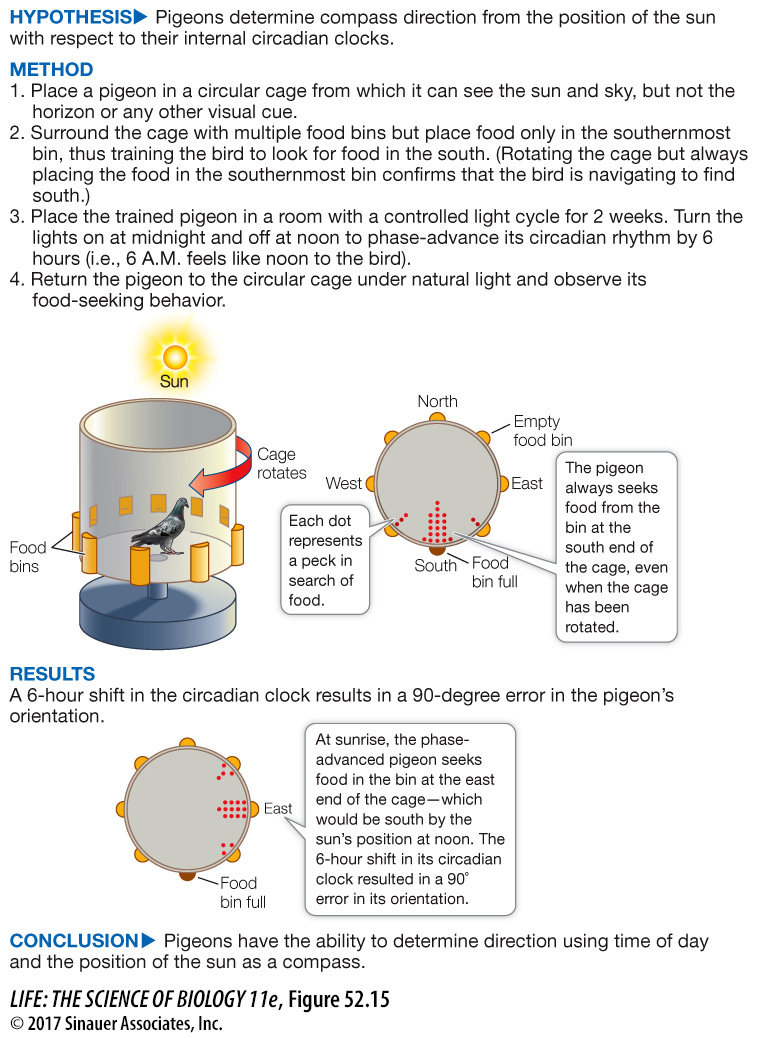Animals must find their way around their environment
To locate suitable habitats, find food and mates, and avoid predators and bad weather, an animal needs to be able to find its way around its environment. Within its local habitat, an animal can orient to landmarks. But what if its destination is a considerable distance away?
PILOTING: ORIENTATION BY LANDMARKS Most animals find their way by knowing and remembering the structure of their environment, a form of navigation called piloting. Gray whales, for example, migrate seasonally between the Bering Sea and the coastal lagoons of Mexico (Figure 52.13). They find their way in part by following the western coast of North America. The rules are simple: keep the land on your right when traveling north and on your left when traveling south. Coastlines, mountain chains, rivers, water currents, and wind patterns can all serve as piloting cues for animals. But many remarkable cases of long-

Activity 52.1 Homing Simulation
HOMING: RETURN TO A SPECIFIC LOCATION The ability to return to a nest site, burrow, or other specific location is called homing. Homing can be accomplished by piloting in a known environment, but some animals that travel long distances through unfamiliar territory perform much more sophisticated homing. The ability of pigeons to return to their home loft even after being transported to remote sites is well known. How do they find their way home? Experiments have shown that pigeons use the sun as a compass, but they can still find their way home when the sun is not visible. Other experiments have shown that pigeons equipped with frosted contact lenses can find their way home, suggesting that visual cues are not essential. Most amazing has been the demonstration that pigeons can detect Earth’s magnetic field and orient to it much as a human orients with a compass. Taken together, the studies of homing by pigeons suggest that they can use multiple, redundant sources of directional information and can switch among those sources depending on the circumstances.
MIGRATION: NAVIGATION OVER GREAT DISTANCES For as long as humans have inhabited high latitudes, they have been aware that entire populations of animals, especially birds, disappear and reappear seasonally. Not until the early nineteenth century, however, were patterns of migration traced by marking individual birds with identification bands around their legs. Only when individuals could be unmistakably identified was it possible to show that the same birds and their offspring returned to the same breeding grounds year after year, and that these same birds could be found during the nonbreeding season at locations hundreds or even thousands of kilometers from their breeding grounds.
Many homing and migrating species take direct routes to their destinations through environments they have never experienced because they use mechanisms of navigation other than piloting. Humans use two major forms of navigation:
Distance–
direction navigation requires knowing in what direction and how far away the destination is. With a compass to determine direction and a means of measuring distance, humans navigate.Bicoordinate navigation, also known as true navigation, requires knowing the latitude and longitude (the map coordinates) of both the current position and the destination, as well as a compass to determine direction.
Many animals seem to have a “compass sense” that allows them to use environmental cues to determine direction, and some seem to have a “map sense” that allows them to determine their position.
The behavior of some animals suggests that they are capable of bicoordinate navigation. Gray-

The ability to locate a position by calculating the angles between celestial objects such as the sun and stars and the horizon at specific times of day is called celestial navigation. During the day, the sun can serve as a compass if you know what time it is, and animals can use their circadian clocks for that information. This capacity has been demonstrated by “clock-
experiment
Figure 52.15 A Time-
Original Paper: Kramer, G. 1952. Experiments on bird orientation. Ibis 94: 265–
Experiments show that pigeons use the sun to establish directions for navigation and finding food. “Clock-

Animation 52.4 Time-
Many animals are normally nocturnal; in addition, many diurnal bird species migrate at night and thus cannot use the sun to determine direction. The stars offer two sources of information about direction: moving constellations and a fixed point. The positions of constellations (like that of the sun) change because Earth is rotating. With a star map and a clock, direction can be determined using any constellation. But one point that does not change position during the night is the point directly over the axis on which Earth turns. In the Northern Hemisphere, the star Polaris—
Stephen Emlen at Cornell University showed that birds can learn to use the stars for orientation. As the time of year approaches when young birds would normally migrate to their winter range, young captive birds become more active and orient their activity in the direction they would fly. How do they know that direction? If these birds are raised in a planetarium with a natural star pattern, but one that does not rotate, the birds do not learn to orient, and their premigratory activity is random. However, if the planetarium sky rotates, and even if it rotates around a different point than the North Star, the birds orient their premigratory activity as if the fixed point in the sky were north.